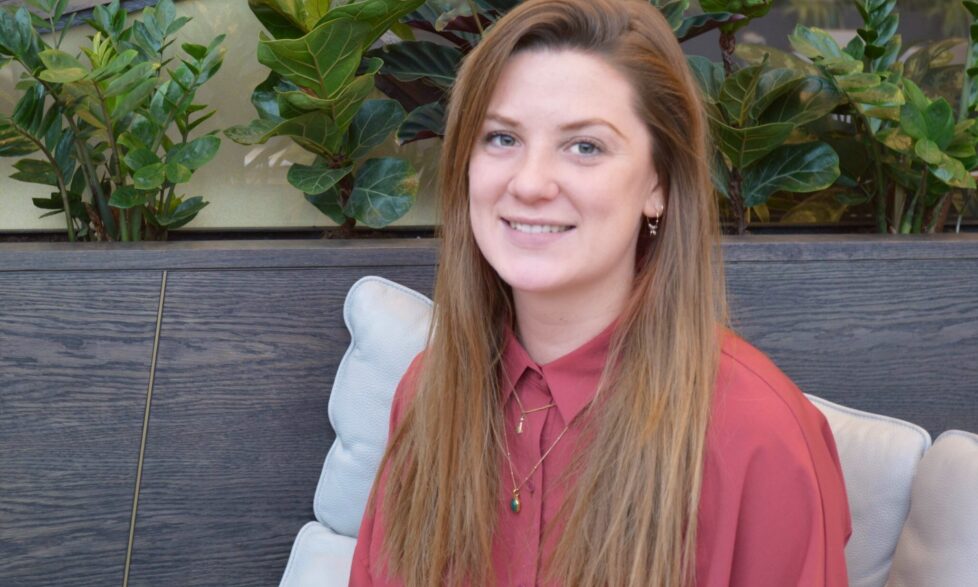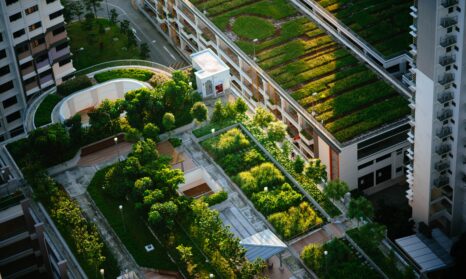“Sustainable places attract people”: Q&A with Alexia Laird at Landsec
Alexia is a Sustainable Design Executive at Landsec, working across their development activities, with a focus on residential-led mixed use masterplans. Previously, she worked as an environmental consultant and then as a sustainability manager for a major contractor in London.
Alexia holds a degree in Environment and Development from LSE and a MSc in Environmental Technology from Imperial College.
What do you see as the biggest opportunities and challenges in the built environment sector?
There are lots of opportunities and lots to be hopeful about. There’s been a seismic shift in recent years in the attitude towards sustainability - it’s being taken seriously. This increased interest presents the biggest opportunity for creating a positive impact I have seen since I started working in the sector.
One of the reasons for this shift is that younger generations are much more in tune with sustainability and they use it more when deciding where to shop or where to live. We’ve seen a much higher demand for it in commercial and residential properties, and it’s really driving our strategy at Landsec. We want our projects to cater to the demands of future generations, which is why we’ve pledged to become a net-zero carbon business by 2030.
In the last 12 months, we’ve also been getting a huge number of enquiries from investors about our sustainability strategies. This is something I’ve never been asked about before, and it highlights how important fighting climate change is to all our stakeholders, which is great.
But we are also facing a lot of challenges. There are some residential schemes in the UK, for example, where developers will have to retrospectively tackle the ability to deliver net zero carbon housing and that will be tough.
We also need to encourage the uptake of timber as a building material to reduce embodied carbon (the carbon created during construction).
What role does policy play in shifting the sector forward, compared to client demand or change from businesses?
Policy plays a really big part in driving change at the pace and scale that is urgently required. I have high hopes for the Future Homes Standard in tackling energy and carbon. But we need to consider things from a much wider perspective. We need to think about placemaking, and policy will be needed for this too.
It’s not to say, however, that progress only comes with policy – at Landsec, for example, we’re working hard to deliver the most sustainable schemes possible, regardless. I am hopeful that, considering the recent shift in mindset, any future-thinking developer will see the value in going above what is asked of us anyway.
I am hopeful that...any future-thinking developer will see the value in going above what is asked of us anyway.
Can you tell me a bit about LETI (London Energy Transformation Initiative) and the work you’ve been doing with it?
LETI is a network of more than 1,000 built environment professionals who are working together to put the UK on the path to a zero-carbon future. It’s producing valuable content to tackle many of the issues we face, getting a wide range of opinions and voices in one place. For example, I got involved in 2019 to review its Climate Emergency Design Guide, looking especially at embodied and operational carbon.
I think cross-sector announcements, like Architects Declare, are incredibly important. But I am wary that sometimes the organisations involved can use different parameters or definitions. That can lead to a confusing landscape, especially when it comes to something like “net zero” where everyone seems to have their own definition. We need to make sure that as an industry, we are talking about the same thing and defining things in the same way. The UKGBC’s definition of net-zero is a good starting point for this and we can then use tools like LETI to build on it collaboratively.
A sustainable place attracts people and increases footfall as it’s simply a place that has been well thought out and well designed.
What do you see as the main benefits of sustainable places?
A sustainable place attracts people and increases footfall as it’s simply a place that has been well thought out and well designed.
This is one of the things I like about One Planet Living. It pushes us to think beyond the technical aspects of the initial design like energy consumption. It enables us to think about what kind of places we are trying to create, how people will live there, how they will walk through it.
At Landsec, we have a dedicated Social Sustainability Team that works on four community programmes to support people furthest from the jobs market into employment, create opportunities for young people and ensure that our activities generate as much social value as possible. In the sustainable design team, we work closely with them and have begun undertaking social value exercises on our future developments asking what the positive public benefits of our schemes are - as well as having a significant social value strategy for our operations.
We do this because we are creating these places for people – this shouldn’t be forgotten. Sustainability should go well beyond looking at carbon, it’s also about understanding local needs – it should consider wellbeing, community, the local economy.
We have a responsibility as developers to create value not just for ourselves, but for the people we are building for and the local community.
We have a responsibility as developers to create value not just for ourselves, but for the people we are building for and the local community.
What else do you like about using One Planet Living?
I focus on residential-led masterplans and One Planet Living provides a holistic approach to considering every aspect of a scheme. It goes beyond the red line boundary of the building, looking at the public realm and how to make it a vibrant place. It does this in a way that is locally specific because it thinks about local needs, but also creates a wider vision that’s essential to any project that wants to take a best-in-class approach to sustainability.
I’ve been using One Planet Living on two of our masterplans and have found two things. First, it creates important conversations with the design team – it gets them engaged. And second, it drives design changes in a way that the other standards we work with don’t, because they are so confined to the red line boundary.
I have seen significant benefits while using One Planet Living and, while local authorities aren’t always aware of it, when you start talking to them about it, they respond well. That makes planning conversations easier because we can show that we have gone above and beyond what is expected of us as a developer.
One Planet Living provides a holistic approach to considering every aspect of a scheme
What do you think the sector can do to show sustainable leadership?
In terms of business-level change, endorsement about sustainability from the top is key. One of the things we’ve done at Landsec is tie sustainability performance to executive renumeration. That’s made the onus of responsibility filter down into all our business activities.
It’s also valuable to make sure different teams work together – as mentioned before, our sustainable design team sits alongside our Social Sustainability Team. We’ve created an effective symbiotic relationship where we learn from one another to achieve our outcomes, especially in terms of people and community-focused benefits.
On an individual level, people within the sector can make change too. Collaborating through initiatives like LETI or other industry working groups is a fantastic way to join forces, as well as foster transparency. True leadership is about being open about mistakes – because we can all learn from them.
I also think it’s important that we champion careers in the sector because we need young people to join the fight. One thing I’ve found incredible at Landsec is our outreach with local schools. We give schoolchildren a project to create a future development and let them run with it. What’s surprised me is that, almost every time, they come back with something that has sustainability at its core.
They haven’t been asked to do this – they’re already thinking about it. As sustainability professionals, we can nurture and build on this enthusiasm by engaging with younger generations to let them know it could be a career path.
We've been working with Landsec since 2018 to support it to use One Planet Living. Learn more about using One Planet Living to create sustainable places.








